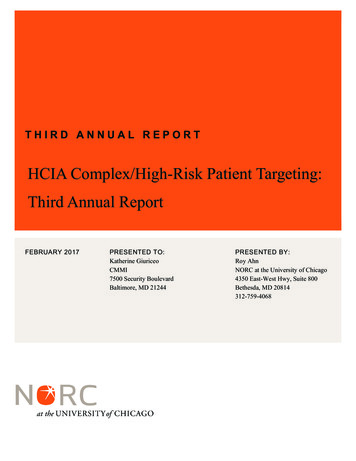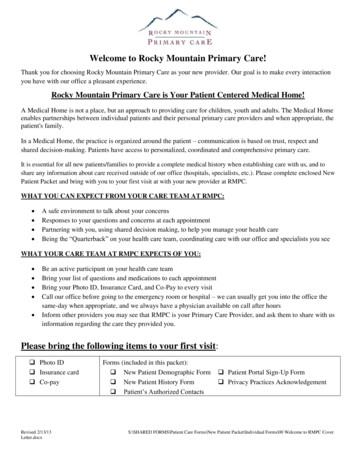
Transcription
THIRD ANNUAL REPORTHCIA Complex/High-Risk Patient Targeting:Third Annual ReportFEBRUARY 2017PRESENTED TO:Katherine GiuriceoCMMI7500 Security BoulevardBaltimore, MD 21244PRESENTED BY:Roy AhnNORC at the University of Chicago4350 East-West Hwy, Suite 800Bethesda, MD 20814312-759-4068
NORC HCIA Complex/High-Risk Patient TargetingContributorsBritta AndersonEmily ArmstrongWilhelmine MillerShriram ParashuramSarah RuizJennifer SatoriusRachel Friedman SingerLynne Page SnyderTHIRD ANNUAL REPORT I
NORC HCIA Complex/High-Risk Patient TargetingTable of ContentsExecutive Summary . 1Introduction and Methods . 21Evaluation Design . 23Quantitative Methods (Claims Based Analyses) . 25Qualitative Methods (Program Documents, Interviews, and Site Visits) . 29Survey Methods . 32Mixed Methods Data Analysis . 33Overview of Awardee Group. 33Assessing Workforce Development . 35Rapid Cycle Evaluation: Revising Issues of Feasibility and Evaluability . 36Awardee-Level Analyses: Overview . 40Beth Israel Deaconess Medical Center . 53California Long-Term Care Education Center . 62Community Care of North Carolina . 77Courage Kenny Rehabilitation Institute . 87Developmental Disabilities Health Services . 101Johns Hopkins University Community Health Partnership . 113Johns Hopkins University School of Nursing . 138LifeLong Medical Care . 154Northland Healthcare Alliance . 165Palliative Care Consultants of Santa Barbara . 176Pittsburgh Regional Health Initiative . 188Providence Portland Medical Center . 199St. Francis Healthcare Foundation of Hawaii . 220South Carolina Research Foundation . 230Sutter Health Corporation . 241THIRD ANNUAL REPORT II
NORC HCIA Complex/High-Risk Patient TargetingUniversity Emergency Medical Services . 255University of Arkansas for Medical Sciences . 266University of Iowa . 276University of New Mexico . 286University of North Texas . 298University of Rhode Island . 314University of Texas Health Science Center at Houston . 324Vanderbilt University Medical Center . 333Serving Complex/High-Risk Beneficiaries: Policy-Relevant Themes and Lessons forDelivery System Reform . 346TECHNICAL APPENDICES . 379Appendix A: Awardee and Intervention Names and Abbreviations . 380Appendix B: Definition of Acronyms . 381Appendix C: Methods, Claims-based Analyses . 383Appendix D: Claims-based Analyses: Supporting Exhibits . 404Beth Israel Deaconess Medical Center . 407California Long-Term Care Education Center . 409Courage Kenny Rehabilitation Institute . 416Developmental Disabilities Health Services . 419Johns Hopkins University . 423Johns Hopkins University School of Nursing . 438LifeLong Medical Care . 441Northland Healthcare Alliance . 442Palliative Care Consultants of Santa Barbara . 444Pittsburgh Regional Health Initiative . 446Providence Portland Medical Center . 449St. Francis Healthcare Foundation of Hawaii . 460South Carolina Research Foundation. 464Sutter Health Corporation . 466University Emergency Medical Services. 470University of Iowa . 472THIRD ANNUAL REPORT III
NORC HCIA Complex/High-Risk Patient TargetingUniversity of New Mexico . 474University of North Texas Health Science Center . 475University of Rhode Island . 480Vanderbilt University Medical Center. 481Appendix E: Methods, Surveys . 486Appendix F: Survey Analyses: Supporting Exhibits . 488Appendix G: Methods, Qualitative . 588Appendix H: List of Evaluation Questions . 590Appendix I: Cross- Awardee Chapter Exhibits . 599THIRD ANNUAL REPORT IV
NORC HCIA Complex/High-Risk Patient TargetingList of ExhibitsExhibit ES.1:Health Care Innovation Awardees, Complex/High-Risk PatientTargeting . 2Exhibit ES.2:Conceptual Framework, Evaluation of the CHRPT Portfolio ofHCIA Awardees . 3Exhibit ES.3:Cost Effects Associated with HCIA One Interventions, by Awardee . 5Exhibit ES.4:Average Quarterly Total Cost of Care, by Awardee . 7Exhibit ES.5:Aggregate Total Cost of Care, by Awardee . 8Exhibit ES.6:Utilization and Quality of Care Effects Associated with HCIA OneInterventions, by Awardee . 11Exhibit 1.1:The Complex/High-Risk Patient Targeting Awardees . 22Exhibit 1.2:Conceptual Framework, Evaluation of the CHRPT Portfolio ofHCIA Awardees . 24Exhibit 1.3:Evaluation Design by Awardee Intervention Type . 26Exhibit 1.4:Data Source and Evaluation Design, by Awardee . 26Exhibit 1.5:Claims-Based Measures of Program Effectiveness, by Awardee . 27Exhibit 1.6:Difference-in-Differences Analysis for Post-Acute (HospitalDesign) and Ambulatory Care (Community Design) Interventions . 29Exhibit 1.7:Administrative Cohorts for NORC Evaluation. 30Exhibit 1.8:No-Cost Extension Telephone Interviews, by Awardee . 31Exhibit 1.9:Survey Data and Analyses Included in NORC Third Annual Report . 33Exhibit 1.10:Beneficiary Populations Served, Complex/High-Risk PatientTargeting Portfolio . 34Exhibit 1.11:Program Models and Practices, Complex/High-Risk PatientTargeting Portfolio . 35Exhibit 1.12:Challenges to Evaluability: Representativeness of Claims Data, ByAwardee . 38Exhibit 2.1:Program Effectiveness: A Visual Guide . 40Exhibit 2.2:Summary, Awardee Chapter Contents for NORC Third AnnualReport. 41Exhibit 2.3:Cost Effects Associated with HCIA One Interventions, by Awardee . 45Exhibit 2.4:Average Quarterly Total Cost of Care, by Awardee . 47Exhibit 2.5:Aggregate Total Cost of Care, by Awardee . 48Exhibit 2.6:Utilization and Quality of Care Effects Associated with HCIA OneInterventions, by Awardee . 50Exhibit BIDMC.1:Total Number of BIDMC Participants, by HCIA Quarter . 55THIRD ANNUAL REPORT V
NORC HCIA Complex/High-Risk Patient TargetingExhibit BIDMC.2Descriptive Characteristics for the PACT and Comparison GroupBeneficiary-Episodes. 57Exhibit BIDMC.3:Impact of PACT Program on Outcomes . 59Exhibit CLTCEC.1:Total Number of CLTCEC Participants, by HCIA Quarter . 65Exhibit CLTCEC.2:Descriptive Characteristics for CLTCEC and Comparison GroupBeneficiaries . 67Exhibit CLTCEC.3:Impact of the CLTCEC Program on Outcomes . 68Exhibit CLTCEC.4:Impact of CLTCEC Program on Outcomes, by Quarter . 68Exhibit CLTCEC.5:Impact of the CLTCEC Program on Outcomes, Second Year afterProgram Enrollment . 69Exhibit CLTCEC.6:Overview of Medicaid Data Received from CLTCEC Health PlanPartners . 69Exhibit CCNC.1:Total Number of CHACC Participants, by HCIA Reporting Quarter . 80Exhibit CKRI.1:Total Number of CKRI Participants, by HCIA Reporting Quarter. 90Exhibit CKRI.2:Descriptive Characteristics for the CKRI and Comparison GroupMedicare Beneficiaries . 92Exhibit CKRI.3:Impact of the CKRI Program on Outcomes for MedicareBeneficiaries . 93Exhibit CKRI.4:Impact of the CKRI Program on Outcomes for MedicareBeneficiaries, by Quarter . 93Exhibit CKRI.5:Descriptive Characteristics for the CKRI Program and ComparisonGroup Medicaid Beneficiaries . 95Exhibit CKRI.6:Impact of the CKRI Program on Outcomes for MedicaidBeneficiaries . 96Exhibit DDHS.1:Total Number of DDHS Participants, by HCIA Reporting Quarter . 103Exhibit DDHS.2:Descriptive Characteristics for DD Health Home and ComparisonGroup Medicare Beneficiaries . 104Exhibit DDHS.3:Impact of DD Health Home Program on Outcomes for MedicareBeneficiaries. 106Exhibit DDHS.4:Descriptive Characteristics for DD Health Home and ComparisonGroup Medicaid Beneficiaries . 107Exhibit DDHS.5:Impact of DD Health Home Program on Outcomes for MedicaidBeneficiaries . 108Exhibit J-CHiP.1:Total Number of J-CHiP Participants, by HCIA Reporting Quarter . 116Exhibit J-CHiP.2:Descriptive Characteristics for the J-CHiP Hospital Arm andComparison Group, Medicare Beneficiary-Episodes . 119Exhibit J-CHiP.3:Impact of J-CHiP Program Hospital Arm on Outcomes, MedicareBeneficiary-Episodes. 121Exhibit J-CHiP.4:Descriptive Characteristics for the J-CHiP Hospital Arm andComparison Group Medicaid Beneficiary-Episodes . 123THIRD ANNUAL REPORT VI
NORC HCIA Complex/High-Risk Patient TargetingExhibit J-CHiP.5:Impact of J-CHiP Program Hospital Arm on Outcomes, MedicaidBeneficiary-Episodes . 125Exhibit J-CHiP.6:Descriptive Characteristics for J-CHiP Community Arm andComparison Group Medicare Beneficiaries . 127Exhibit J-CHiP.7:Impact of J-CHiP Program Community Arm on Outcomes for MedicareBeneficiaries . 128Exhibit J-CHiP.8:Impact of J-CHiP Program Community Arm on Total Cost of Care forMedicare Beneficiaries, by Quarter .129Exhibit J-CHiP.9:Descriptive Characteristics for J-CHiP Community Arm andComparison Group Medicaid Beneficiaries . 130Exhibit J-CHiP.10:Impact of J-CHiP Program Community Arm on Outcomes for MedicaidBeneficiaries . 132Exhibit JHUSON.1:Total Number of JHU SON Participants, by HCIA ReportingQuarter . 140Exhibit JHUSON.2:Descriptive Characteristics for CAPABLE and Comparison GroupBeneficiaries Medicare Analysis. 142Exhibit JHUSON.3:Impact of Project CAPABLE Program on Outcomes for MedicareBeneficiaries . 143Exhibit JHUSON.4:Impact of Project CAPABLE Program on Outcomes for MedicareBeneficiaries, by Quarter . 144Exhibit JHUSON.5:Descriptive Characteristics for Project CAPABLE and ComparisonGroup Beneficiaries Medicaid Analysis . 145Exhibit JHUSON.6:Impact of Project CAPABLE Program on Outcomes for MedicaidAnalysis . 146Exhibit JHUSON.7:Impact of Project CAPABLE Program on Outcomes for MedicaidBeneficiaries, by Quarter . 147Exhibit LCCI.1:Total Number of LCCI Participants, by HCIA Reporting Quarter. 157Exhibit LCCI.2:Descriptive Characteristics for LCCI and Comparison GroupBeneficiaries. 159Exhibit LCCI.3:Impact of the LCCI Program on Outcomes . 160Exhibit NHA.1:Total Number of NCCS Participants, by HCIA Reporting Quarter . 167Exhibit NHA.2:Descriptive Characteristics for NCCS and Comparison GroupBeneficiaries . 169Exhibit NHA.3:Impact of the NCCS Program on Outcomes . 170Exhibit PCCSB.1:Total Number of PCCSB Participants, by HCIA Reporting Quarter . 178Exhibit PCCSB.2:Descriptive Characteristics for DASH and Comparison GroupBeneficiaries . 180Exhibit PCCSB.3:Impact of DASH on Outcomes for Medicare Beneficiaries . 181Exhibit PRHI.1:Total Number of PRHI Participants, by HCIA Reporting Quarter. 190THIRD ANNUAL REPORT VII
NORC HCIA Complex/High-Risk Patient TargetingExhibit PRHI.2:Descriptive Characteristics for PCRC and Comparison Group MedicareBeneficiary-Episodes . 192Exhibit PRHI.3:Impact of PCRC on Outcomes . 193Exhibit PRHI.4:Impact of PCRC on Patients with Acute Myocardial Infarction . 194Exhibit PRHI.5:Impact of PCRC on Patients with Congestive Heart Failure . 195Exhibit PRHI.6:Impact of PCRC on Patients with Chronic Obstructive PulmonaryDisease . 195Exhibit PPMC.1:Total Number of Health Commons Participants, by HCIA Quarter . 201Exhibit PPMC.2:Claims-based Findings for PPMC Programs . 202Exhibit PPMC.3:Descriptive Characteristics for PPMC Health Resilience Program andComparison Group Beneficiaries . 203Exhibit PPMC.4:Impact of the PPMC Health Resilience Program on Outcomes . 204Exhibit PPMC.5:Descriptive Characteristics for PPMC New Directions and ComparisonGroup Beneficiaries . 206Exhibit PPMC.6:Impact of the PPMC New Directions Program on Outcomes . 207Exhibit PPMC.7:Descriptive Characteristics for PPMC ED Guides and ComparisonGroup Beneficiaries . 208Exhibit PPMC.8:Impact of PPMC ED Guides Program on Outcomes . 210Exhibit PPMC.9:Descriptive Characteristics for PPMC Standard Transitions andComparison Group Beneficiaries . 211Exhibit PPMC.10:Impact of PPMC Standard Transitions Program onOutcomes . 212Exhibit PPMC.11:Descriptive Characteristics for PPMC C-TRAIN and ComparisonGroup Beneficiaries . 213Exhibit PPMC.12:Impact of PPMC C-TRAIN on Outcomes . 215Exhibit PPMC.13:Descriptive Characteristics for ITT PPMC Participants andComparison Group Beneficiaries . 216Exhibit HOPE.1:Total Number of H.O.P.E. Participants, by HCIA Reporting Quarter . 222Exhibit HOPE.2:Descriptive Characteristics for H.O.P.E. Hospital Arm and ComparisonGroup Beneficiary-Episodes . 224Exhibit HOPE.3:Impact of H.O.P.E. Program on Outcomes, Hospital Arm . 225Exhibit HOPE.4:Descriptive Characteristics for H.O.P.E. Community Arm andComparison Group Beneficiaries . 226Exhibit HOPE.5:Impact of the H.O.P.E. Program on Outcomes, Community Arm . 227Exhibit SCRF.1:Total Number of SCRF Participants, by HCIA Reporting Quarter . 232Exhibit SCRF.2:Descriptive Characteristics for HOMECARE and ComparisonGroup Beneficiaries . 233Exhibit SCRF.3:Impact of the HOMECARE Program on Outcomes. 235THIRD ANNUAL REPORT VIII
NORC HCIA Complex/High-Risk Patient TargetingExhibit SCRF.4:Impact of HOMECARE Program on Outcomes, by Quarter. 236Exhibit AIM.1:Total Number of AIM Participants, by HCIA Reporting Quarter . 243Exhibit AIM.2:Descriptive Characteristics for AIM and Comparison GroupBeneficiaries, End-of-Life Analysis . 245Exhibit AIM.3:Impact of AIM Program on Outcomes, End of LifeAnalysis. 246Exhibit AIM.4:Differences in Survival for AIM Participants and Comparators . 248Exhibit AIM.5:Descriptive Characteristics for AIM and Comparison GroupMedicare Beneficiaries . 248Exhibit UEMS.1:Total Number of HealthiER Participants, by HCIA Reporting Quarter . 257Exhibit UEMS.2:Descriptive Characteristics for HealthiER and Comparison GroupBeneficiaries . 259Exhibit UEMS.3:Impact of HealthiER on Outcomes . 260Exhibit UEMS.4:Impact of the HealthiER Program on Outcomes, by Quarter . 261Exhibit UIHC.1:Total Number of U Iowa Participants, by HCIA Reporting Quarter . 278Exhibit UIHC.2:Descriptive Characteristics for Transitional Care Teams andComparison Group Beneficiary-Episodes . 280Exhibit UIHC.3:Impact of Transitional Care Teams on Outcomes . 281Exhibit UIHC.4:U Iowa Consumer Experience Survey Items . 282Exhibit ECHO.1:Total Number of ECHO Care Participants, by HCIA Reporting Quarter . 289Exhibit ECHO.2:Descriptive Characteristics for the ECHO Care Comparison GroupBeneficiaries . 291Exhibit ECHO.3:Impact of ECHO Care on Outcomes. . 291Exhibit ECHO.4:Impact of the ECHO Care Program on Outcomes, by Quarter . 292Exhibit BSLTOC.1:Number of Implementation Sites, Brookdale Senior Living . 299Exhibit BSLTOC.2:INTERACT Tools Used, by Setting . 300Exhibit BSLTOC.3:Total Number of BSLTOC Participants, by HCIA Reporting Quarter. 301Exhibit BSLTOC.4:Descriptive Characteristics for BSLTOC and Comparison GroupBeneficiary-Episodes, SNF Analysis . 303Exhibit BSLTOC.5:Impact of the BSLTOC Program on Outcomes, SNF Analysis . 304Exhibit BSLTOC.6:Descriptive Characteristics for BSLTOC and Comparison GroupBeneficiaries, Assisted Living/Memory Care Analysis . 305Exhibit BSLTOC.7:Impact of BSLTOC Program on Outcomes, Asisted Living/MemoryCare Analysis . 306Descriptive Characteristics for BSLTOC and Comparison GroupBeneficiaries, End of Life Analysis . 308Exhibit BSLTOC.8:Exhibit BSLTOC.9:Impact of BSLTOC Program on Outcomes, End-of-Life Analysis . 308Exhibit RIte.1:Total Number of Living RIte Enrollees, by HCIA Reporting Quarter . 316THIRD ANNUAL REPORT IX
NORC HCIA Complex/High-Risk Patient TargetingExhibit RIte.2:Descriptive Characteristics for Living RIte and Comparison GroupBeneficiaries . 318Exhibit RIte.3:Impact of the Living RIte Program on Outcomes . 319Exhibit RIte.4:Impact of the Living RIte Program on Outcomes, by Quarter . 320Exhibit HRCC.1:Total Number of HRCC Participants, by HCIA Reporting Quarter . 326Exhibit HRCC.2:Enrollment for Treatment and Control Groups in the First andSecond Phase of HRCC Program . 327Exhibit HRCC.3:Descriptive Characteristics for HRCC and Comparison GroupBeneficiaries . 328Exhibit HRCC.4:Impact of the HRCC Program on Outcomes, by Study Phase . 329Exhibit VUMC.1:Total Number of VUMC Participants, by HCIA Reporting Quarter . 335Exhibit VUMC.2:Descriptive Characteristics for IMPACT-INTERACT andComparison Group Beneficiary-Episodes, Hospital Analysis . 337Exhibit VUMC.3:Impact of IMPACT-INTERACT Program on Outcomes, HospitalAnalysis . 339Exhibit VUMC.4:Impact of IMPACT-INTERACT Program on ED Visits, HospitalAnalysis, by Quarter . 340Exhibit VUMC.5:Effect of IMPACT-INTERACT Program by Number of GeriatricSyndromes, Community Analysis. 342Exhibit VUMC.6:Descriptive Characteristics for IMPACT-INTERACT andComparison Group Beneficiaries, End of Life Analysis . 343Exhibit VUMC.7:Impact of IMPACT-INTERACT Program on Outcomes, End-of-LifeAnalysis . 344Exhibit 3.1:Populations Served by Complex/High-Risk Patient TargetingAwardees . 347Exhibit C.1:Intervention Settings by Awardee. 384Exhibit C.2:Methodological Overview by Evaluation Design . 384Exhibit C.3:Types of Analyses for Claims-Based Measures in NORC ThirdAnnual Report . 386Exhibit C.4:Status of Medicaid Data Sources . 388Exhibit C.5:Sampling Frame for Comparison Groups, Hospital EvaluationDesign Awardees . 391Exhibit C.6:SMR Weights from Logistics Propensity Score Model . 392Exhibit C.7:Relative Weights from Multinomial Logit Propensity Score Model . 393Exhibit C.8:Sampling Frame for Comparison Groups, Community EvaluationDesign . 398Exhibit C.9:Propensity Score Approach for Comparison Groups, CommunityEvaluation Design . 400THIRD ANNUAL REPORT X
NORC HCIA Complex/High-Risk Patient TargetingExhibit D.1:Analyses that Include Common Support and Covariance BalanceCharts by Awardee . 405Exhibit D.2:Analyses that Include Quarterly Fixed Effects Charts of the Impactof HCIA-Funded Innovations on Outcomes by Quarter by Awardee . 406Exhibit D.BIDMC.1:Common Support and Covariate Balance for PACT andComparison Beneficiary-Episodes . 407Exhibit D.BIDMC.2:Impact of the PACT Program on Outcomes by Quarter . 408Exhibit D.CLTCEC.1: Common Support and Covariate Balance for CLTCEC andComparison Participants, Medicare Analysis . 4
THIRD ANNUAL REPORT HCIA Complex/High-Risk Patient Targeting: Third Annual Report FEBRUARY 2017 PRESENTED TO: Katherine Giuriceo . CMMI . 7500 Security Boulevard










